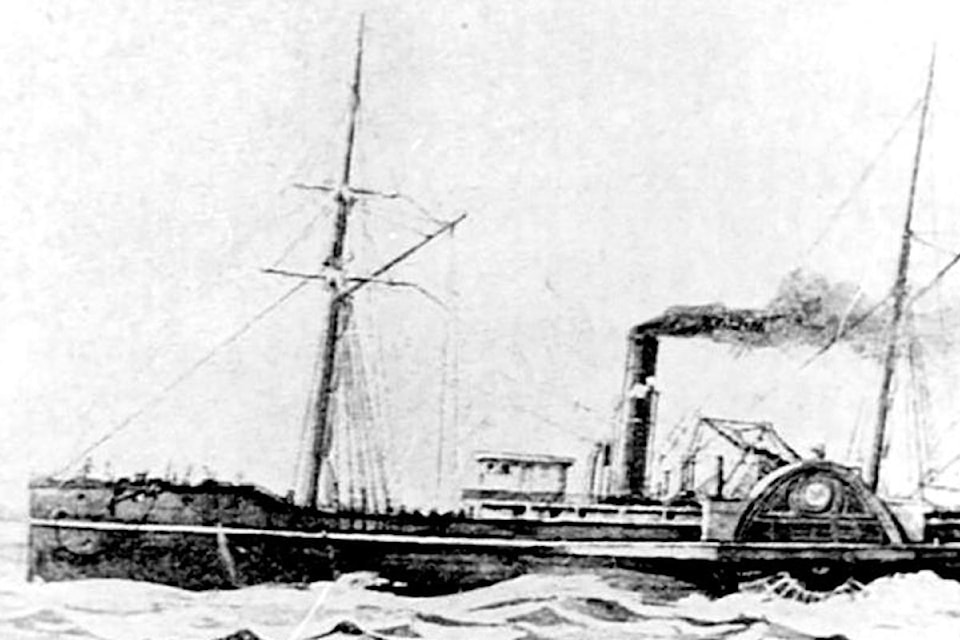The date, November 4, 1875. The sidewheel steamship, SS Pacific, was enroute to San Francisco from Victoria. As it rounded Cape Flattery on the Washington Territory coast, it struck a freighter, the Orpheus. The Pacific, captained by Jefferson Davis Howell, sank quickly in 1000 feet of water.
Charles Sawyer, captain of the Orpheus, said he first confirmed his ship was not at risk, after which the Pacific was not visible. The Orpheus then sailed onward, relatively undamaged. With that, the death of almost all who escaped the ill-maintained Pacific was tragically unavoidable.
Two hundred seventy-five people, perhaps more, were on the ship, of which 48 were crew. Two hundred seventy-three people perished. Only two survived. Residents of Victoria, San Francisco and many other towns and cities were among the deceased, each of them leaving bereaved family and friends.
The SS Pacific was built in 1850 in New York. In 1851, it was chartered by Cornelius Vanderbilt for the Pacific leg of his New York to San Francisco route. His steamships docked on the Atlantic and Pacific coasts of Nicaragua, and passengers were transported across the country to continue their voyage. Transit problems in Nicaragua and its civil war plagued the venture.
The SS Pacific was withdrawn, and in 1858 began service between San Francisco and the Columbia River. It hit a large rock on the Columbia and sank in 1861. It was raised and repaired, and served to 1872. History Link states, ş¦Đ߲ÝŃĐľżËůśshe was retired and left to rot on the mudflats of San Francisco Bay.ş¦Đ߲ÝŃĐľżËůť
In 1873, with the Cassiar goldrush building, demand for steamships grew. The Pacific, supposedly rebuilt and seaworthy, was certified by the U.S. regulator. The Pacific was soon plying the Victoria -San Francisco route. Unknown to the passengers, the repairs had largely been cosmetic.
On November 4th, the Pacific steamed out of Esquimalt. Day turned to evening, and darkness. Two of the only three crewmen on duty were inexperienced. The ship listed heavily. This implies that water may have pooled in the hull. The ship was leaking. The captain ordered the crew to pump water into some of the life boats. Lights were out on the port side.
The Orpheus sighted the oncoming Pacific, and turned hard to port, but the abrupt move left the sail ship dead in the water. The Pacific continued to steam toward the Orpheus, the Pacificş¦Đ߲ÝŃĐľżËů™s crew evidently oblivious. Only at the last moment, the Pacific sounded her whistle and reversed her engines. The starboard side of the Pacific delivered a glancing blow to the Orpheus three times.
The Pacificş¦Đ߲ÝŃĐľżËů™s starboard planks buckled. While the captain of the Orpheus assessed its damage, the Pacific rapidly took on water, broke apart and within 20 minutes sank. The crew had struggled to launch the lifeboats. The lone surviving passenger, Henry Jelley, said he climbed into a lifeboat carrying mostly women. It had been partly filled with water, and immediately capsized upon launch.
Jelley and four men scrambled onto the inverted boatş¦Đ߲ÝŃĐľżËů™s bottom. The women sadly drowned. Jelley and one of the men climbed onto the wreckage of the pilot house as it floated by. The other man succumbed to exposure. Jelley was rescued by a passing ship off the coast of Vancouver Island.
The only crewman to survive, Neil Henley, said most lifeboats were filled with water or had no plugs or no oars. He launched and boarded a lifeboat with 15 women and six men, but it immediately capsized. He swam to a chunk of the deck, which had seven people on it including the captain and first mate. All were washed away by waves or died from exposure. Only Henley was later rescued.
Witnesses at the Coronerş¦Đ߲ÝŃĐľżËů™s Inquest in Victoria confirmed that the Pacificş¦Đ߲ÝŃĐľżËů™s hull was rotten and leaked badly. The inquest ruled that the collision was caused by the Orpheus crossing the Pacificş¦Đ߲ÝŃĐľżËů™s bow. It also faulted the Pacificş¦Đ߲ÝŃĐľżËů™s crew for negligence and incompetence. It determined that the Pacific was unseaworthy, and the five life boats with a capacity of 160 people were neither adequate in number and nor properly equipped.
The inquest ruled Captain Sawyer guilty of manslaughter for leaving the scene without determining the fate of the Pacific. The captain suffered no punishment because he declined to attend the hearing, and remained in the U.S. Ironically, two days after the wreck of the Pacific, Captain Sawyer had run the Orpheus aground in Barkley Sound on Vancouver Island. It never sailed again.
Jeff Hummel of Seatle located the wreckage of the SS Pacific, after a decades long search, and in 2022 was granted salvage rights. The ship was reputed to hold a strongbox with $79,200 in cash and transported an estimated $100,000 in gold, worth $10 million today. Hummel and his team intend to recover artifacts in the summers of 2024 and 2025
____
Bruce Uzelman, based in Kelowna, holds interests in British Columbia history as wells as current political and economic issues.
Bruce had a career in small business, primarily restaurant and retail. He holds a Bachelor of Arts, Advanced from the University of Saskatchewan, with Majors in Political Science and Economics.
Contact: urban.general@outlook.com



